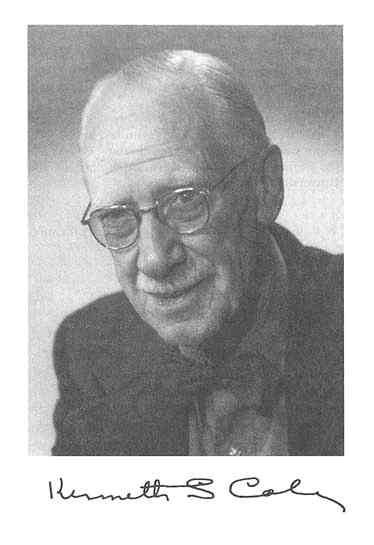Name Kenneth Cole | ||
 | ||
Alma mater Oberlin CollegeCornell University Books Membranes, Ions, and Impulses: A Chapter of Classical Biophysics Awards Guggenheim Fellowship for Natural Sciences, US & Canada, National Medal of Science for Biological Sciences | ||
Kenneth Stewart Cole | Wikipedia audio article
Kenneth Stewart Cole (July 10, 1900 – April 18, 1984) was an American biophysicist described by his peers as "a pioneer in the application of physical science to biology". Cole was awarded the National Medal of Science in 1967.
Contents
- Kenneth Stewart Cole Wikipedia audio article
- Biography
- Electrical Model of Tissue
- Publications
- References
Biography
He was born on July 10, 1900 in Ithaca, New York to Charles Nelson Cole, an instructor in Latin at Cornell University and Mabel Stewart. Kenneth had a younger brother, Robert H. Cole, with whom he remained very close throughout his life despite a large difference in age; they were joint authors of four papers published between 1936 and 1942.
In 1902 the family moved to Oberlin, Ohio, when his father took a post at Oberlin College. His father would later become the Dean. Kenneth's mother was, and
Cole graduated from Oberlin College in 1922 and received a Ph.D. in physics with Floyd K. Richtmyer from Cornell University in 1926. He spent summers working at the General Electric laboratory in Schenectady, New York.
In 1932, Cole married Elizabeth Evans Roberts, an attorney. Later, her work was mostly concerned with civil rights and in 1957 she joined the staff of the United States Commission on Civil Rights
Kenneth joined the staff of Columbia University in 1937 and remained there until 1946. He had also been associated with the Presbyterian Hospital, and the Guggenheim Foundation for Advanced Study at Princeton University and the University of Chicago.
From 1949 to 1954 he was the technical director of the Naval Medicine Research Institute in Bethesda, Maryland. In 1954 he became chief of the laboratory of biophysics of the National Institute of Neurological Diseases and Blindness.
He achieved advances that led to the "sodium theory" of nerve transmission that later won Nobel Prizes for Alan L. Hodgkin and Andrew F. Huxley in 1947. Cole was elected a member of the National Academy of Sciences in 1956, and a Fellow of the American Academy of Arts and Sciences in 1964. He was awarded the National Medal of Science in 1967, the award citation, read: "As a result, we know far more about how the nervous system functions." In 1972 he was made a member of the Royal Society of London. The Biophysical Society awards the Kenneth S. Cole medal to a scientist studying cell membranes.
In 1980 he became an adjunct professor of the Department of Neurosciences at the Scripps Institute of Oceanography in San Diego. He had a son, Roger Braley Cole, and a daughter, Sarah Roberts Cole.
He died on April 18, 1984 in La Jolla, California.
Electrical Model of Tissue
Tissue can be modeled as an electrical circuit with resistive and capacitive properties:
Its dispersion and absorption are represented by the empirical formula:
In this equation
It is worth emphasizing that the Cole–Cole model is an empirical model of the measured data. It has been successfully applied to a wide variety of tissues over the past 60 years, but it does not give any information about the underlying causes of the phenomena being measured.
Several references in the literature use a form of the Cole equation written in terms of impedance instead of a complex permittivity. The impedance
Where
